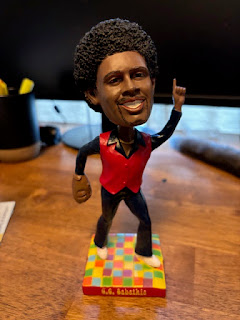I suppose the title is a bit confusing if you have been following my long term, but infrequent series on the players featured in my signed 1960 and 1961 Fleer collection. To the extent that your interest rises to that level, allow me to clear it up. This post will feature my 18th signed 1960 Fleer card and my 44th signed 1961 Fleer card since they are both the same player: Hall of Famer Sam Rice
What is interesting about Sam Rice:
- Over the course of a 20 season major league career, he tallied up 2,987 hits.
- He actually broke in as a pitcher. He appeared in 9 games over his first two seasons compiling a 1-1 record with a 2.52 ERA. In his first ML season, he only appeared as a pitcher, but hit .375.
- He didn't appear in professional baseball until the age of 22 in 1912. Prior to that, he did play semi-pro ball in Watseka, IL where he worked on his family farm. At the time of his pro debut, Sam had already been married for 4 years and had two children.
- Unfortunately, his wife, both children, mother and two sisters were killed by a tornado. The storm was part of a multi-day tornado outbreak which was significant enough to merit it's own Wikipedia page.
- Following the 1912 season, he ended up in the Navy and stationed on the battleship USS New Hampshire. He and his shipmates were part of a landing force that took the port city of Veracruz after tensions between the US and Mexico escalated.
- In 1914, after his furlough from the Navy, he resumed is baseball career with the Petersburg Goobers of the Virginia League. The following year, the Goobers struggled financially (as well as on the field) and the owner of the team gave Rice's contract to the major league Washington Nationals in repayment for a loan.
- In 1916, after several successful appearances as a pinch hitter, he became a full time outfielder.
- Rice didn't have much power, stroking only 34 home runs over the course of his career. He did have speed and had 351 stolen bases over his 20 years and hit over 30 doubles in 10 of those seasons.
- During spring training in 1918, he was drafted into the military and deployed to France. However, WW1 ended before he saw any combat and he found himself back at Spring Training in 1919.
- He and teammate Joe Judge held the record for longevity as teammates after 18 seasons together with Washington. The record has been broken twice in recent decades, first by George Brett and Frank White, then by Alan Trammel and Lou Whitaker.
- In Game 3 of the 1925 World Series, Rice made a catch on a long drive by Pirates catcher Earl Smith that saw him fall over the outfield wall and not return to sight until after a short delay. Controversy ensued whether he really successfully caught the ball. It waw ruled he did and, well into his retirement when asked if he truly caught that ball he always responded, "the umpires said I did."
- He continued to play well through is age 42 season, after which his decline was notable. After the 1933 season he was released and signed with Cleveland to play for his former teammate and Nationals manager Walter Johnson. He struggled as the season wore on and finally retired in September.
- In retirement, he had a chicken farm for a while, bred racing pigeons, and invested in real estate.
- Sam Rice was elected to the Hall of Fame by the Veteran's Committee in 1963 and was a regular at the induction ceremonies through 1974, after which he passed away.
- In 1965, at the request of a HOF historian he wrote a letter documenting the definitive story of that controversial catch in the '25 World Series with the stipulation that it not be opened until after his death. Once the letter was subsequently found and opened, it was revealed that Sam had made the catch and never lost possession of the ball. The delay in returning to the field was due to being dazed by the fall on the opposite side of the outfield wall. However, the controversy was never resolved as there were witnesses who continued to claim the opposite.
















































